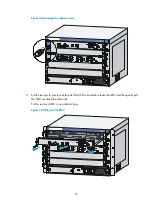
67
Managing interfaces and transceiver modules
Managing combo interfaces
Combo interfaces are logical interfaces. A combo interface comprises one SFP fiber port and one RJ-45
copper port. The two ports cannot work simultaneously because they share the same forwarding
interface. If one port is enabled, the other port is automatically disabled.
Verifying a fiber or copper port
You can use the
display interface
interface-type interface-number
command
to identify the SFP fiber port
and RJ-45 copper port.
•
If the command output includes "Media type is not sure, Port hardware type is No connector", the
port is an SFP fiber port. As shown in the following output, GigabitEthernet 1/1 is an SFP fiber port.
[Sysname] display interface GigabitEthernet 1/1
GigabitEthernet1/1 current state: DOWN
IP Packet Frame Type: PKTFMT_ETHNT_2, Hardware Address: 0000-fc00-7506
Description: GigabitEthernet1/1 Interface
Loopback is not set
Media type is not sure,Port hardware type is No connector
Unknown-speed mode, unknown-duplex mode
Link speed type is autonegotiation, link duplex type is autonegotiation
•
If the command output includes "Media type is twisted pair, Port hardware type is 1000_BASE_T",
the port is an RJ-45 copper port. As shown in the following output, GigabitEthernet 2/1 is an RJ-45
copper port.
[Sysname] display interface GigabitEthernet 2/1
GigabitEthernet2/1 current state: DOWN ( Administratively )
IP Packet Frame Type: PKTFMT_ETHNT_2, Hardware Address: 0000-fc00-7506
Description: GigabitEthernet2/1 Interface
Loopback is not set
Media type is twisted pair
Port hardware type is 1000_BASE_T
Unknown-speed mode, unknown-duplex mode
Link speed type is autonegotiation, link duplex type is autonegotiation
Configuring combo interfaces
Step Command
Remarks
1.
Enter system view.
system-view
N/A
2.
Enter interface view.
interface
interface-type
interface-number
N/A
3.
Activate the copper or fiber
port of a combo interface.
combo enable
{
copper
|
fiber
}
Required.
By default, the copper port is activated.






























